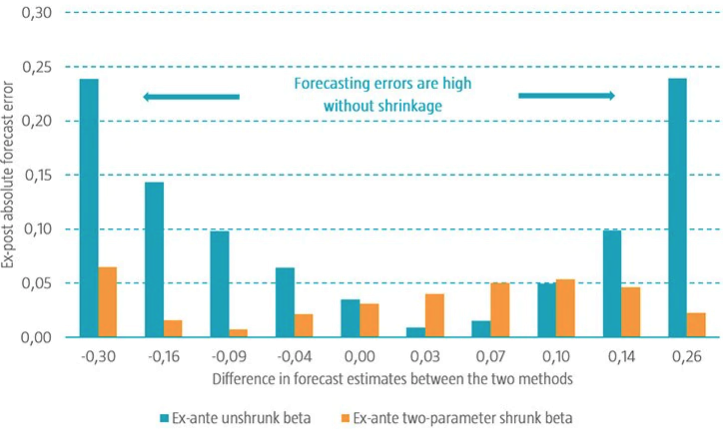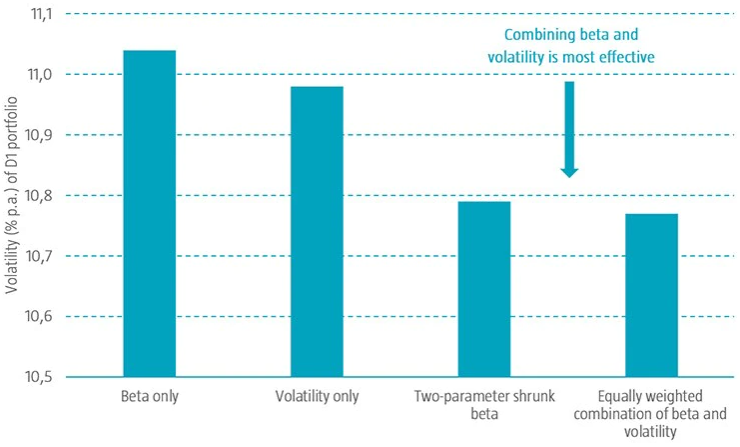In the capital asset pricing model (CAPM), beta is used to describe how the returns of a particular stock (or portfolio) are related to those of the market. It is defined as the correlation between a specific stock (or portfolio) and the market, multiplied by the relative volatility of the stock (or portfolio) versus the market.
Beta is, however, an unobserved characteristic that needs to be estimated. Thus, finding the best way to forecast the beta of securities is an important consideration for academics and practitioners. But more importantly, dealing with the accompanying estimation error is a crucial step in the process. Robeco researchers tackled these issues in an academic paper1 that focused on beta estimations using shrinkage techniques, by looking at the US stock market from January 1963 to December 2017.
Beta shrinkage lowers estimation errors
For the study, the authors assumed that correlations and relative volatilities are independent of each other, such that beta expectations are equal to the product of these two estimated components. To examine which approach best forecasts beta, they analyzed a range of methods, from those that shrink the beta in its entirety, to others that reduce estimation errors in correlations and relative volatilities to their cross-sectional averages separately.
To investigate the effect of implementing shrinkage on correlations and relative volatilities, they looked at the resulting mean squared errors (MSE) of the beta estimates when correlations and relative volatilities were shrunk at different levels. This ranged from a shrinkage factor of 0 to 1 for both parameters.
The analysis confirmed that the largest estimation error – or highest MSE – occurred when no shrinkage was implemented. Meanwhile, a two-parameter approach – that reduced correlations (0.5 shrinkage factor) more than relative volatilities (0.2 shrinkage factor) – produced the best outcome (or lowest MSE). Moreover, one-parameter settings generally delivered suboptimal results.
The researchers also scrutinized stocks that had the most dissimilar beta predictions when the no shrinkage and two-parameter shrinkage approaches were applied. This comparison was also made between the related estimates of the one-parameter shrinkage and two-parameter shrinkage settings. Thereafter, the stocks were ranked on the differences in beta forecasts between these methods and allocated to 10-decile portfolios. The average ex-ante beta estimates for these portfolios were then compared with their realized betas over the full sample period.
The results revealed that the two-parameter shrinkage method had lower forecasting errors than the other two approaches. Indeed, Figure 1 shows the ex-post absolute beta forecast error for both the no shrinkage and two-parameter shrinkage settings for each of the 10-decile portfolios, while the horizontal axis reflects the differences in ex-ante average beta estimates between the two methods.
Figure 1 | Decile portfolios sorted on beta estimate differences between no shrinkage and two-parameter shrinkage methods

Source: Blitz, D., Swinkels, L., Ūsaitė, K., and Van Vliet, P., December 2021, “Shrinking beta”, SSRN working paper.
“
Improved ex-ante beta estimates at the individual stock level led to lower ex-post portfolio betas
Shrunk betas result in less risky portfolios
The authors also assessed whether these improved ex-ante beta estimates at the individual stock level led to lower ex-post portfolio betas. They ranked stocks on their historical beta estimates and allocated them to 10-decile portfolios. The same exercise was performed using the two-parameter shrinkage beta forecasts. In addition, a long-short strategy based on a long position in the D1 portfolio (lowest beta estimates) and short position in D10 portfolio (highest beta estimates) was constructed.
For the strategies based on historical beta estimates, the results showed that the D1 portfolio had an average excess return of 7.26%, volatility of 11.04%, Sharpe ratio of 0.66, and market beta of 0.45. On the other hand, the D10 portfolio also had an average return of 7.26%, but a volatility of 32.59%, Sharpe ratio of 0.22, and a market beta of 1.65. Meanwhile, the long-short portfolio exhibited an alpha of 10.14% relative to the CAPM.
For the strategies based on the two-parameter shrinkage beta estimates, the D1 portfolio had a lower ex-post beta (from 0.45 to 0.42) and a lower realized volatility (from 11.04% to 10.79%). In addition, the D10 portfolio had a higher volatility and a higher ex-post beta. This also indicates that risk can be better predicted on an overall portfolio level. Finally, the long-short portfolio delivered a CAPM alpha that was almost 2% higher (from 10.14% to 11.87%) and that was statistically significant.
Comparing low beta and Low Volatility portfolios
In their paper, the researchers found that beta predictions were more accurate when correlations were shrunk more to their cross-sectional average than relative volatilities. For portfolio construction purposes, these results could be seen as a reason to allocate less weight to estimated correlations than forecasted relative volatilities. To assess this notion, the authors took a different approach and formed portfolios based on either two-parameter shrunk betas, volatility, or a combination of these two variables. This analysis gave them insight on the effect of including correlations alongside volatilities, thereby connecting the literature of low beta and low volatility investing.
When different portfolio combinations based on shrunk beta estimates and volatilities were evaluated, the results revealed that including correlation significantly reduced the volatility of a low-risk portfolio. Therefore, this indicates that correlation is indeed an important element to consider within a low volatility portfolio.
“
An equally weighted combination of unshrunk betas and volatility are most effective in reducing volatility
However, sorting stocks into portfolios based on their conventional betas gives too much weight to the correlation, which is less accurately forecasted. This can be reduced, however, by shrinking correlations more to their cross-sectional average than volatilities, or by combining conventional betas with pure volatility estimates. This latter approach of equally combining beta and volatility is less complex because there is no need to estimate shrinkage parameters.
This concept is illustrated in Figure 2, which shows that the portfolios based only on conventional beta exhibit the highest realized volatility. Furthermore, it depicts that standalone volatility is a better predictor than standalone beta. Meanwhile, those that are based on two-parameter shrunk betas or use an equally weighted combination of unshrunk betas and volatility are most effective in reducing volatility.
Figure 2 | Comparing the realized volatilities of portfolios based on four different construction methods

Source: Blitz, D., Swinkels, L., Ūsaitė, K., and Van Vliet, P., December 2021, “Shrinking beta”, SSRN working paper.
All in all, the results from this research paper indicate that correlations can help enhance the risk-return outcomes of low-risk portfolios. But since they are less accurately estimated than volatilities, they should be handled with care.
Read the full research paper免責聲明
本文由荷宝海外投资基金管理(上海)有限公司(“荷宝上海”)编制, 本文内容仅供参考, 并不构成荷宝上海对任何人的购买或出售任何产品的建议、专业意见、要约、招揽或邀请。本文不应被视为对购买或出售任何投资产品的推荐或采用任何投资策略的建议。本文中的任何内容不得被视为有关法律、税务或投资方面的咨询, 也不表示任何投资或策略适合您的个人情况, 或以其他方式构成对您个人的推荐。 本文中所包含的信息和/或分析系根据荷宝上海所认为的可信渠道而获得的信息准备而成。荷宝上海不就其准确性、正确性、实用性或完整性作出任何陈述, 也不对因使用本文中的信息和/或分析而造成的损失承担任何责任。荷宝上海或其他任何关联机构及其董事、高级管理人员、员工均不对任何人因其依据本文所含信息而造成的任何直接或间接的损失或损害或任何其他后果承担责任或义务。 本文包含一些有关于未来业务、目标、管理纪律或其他方面的前瞻性陈述与预测, 这些陈述含有假设、风险和不确定性, 且是建立在截止到本文编写之日已有的信息之上。基于此, 我们不能保证这些前瞻性情况都会发生, 实际情况可能会与本文中的陈述具有一定的差别。我们不能保证本文中的统计信息在任何特定条件下都是准确、适当和完整的, 亦不能保证这些统计信息以及据以得出这些信息的假设能够反映荷宝上海可能遇到的市场条件或未来表现。本文中的信息是基于当前的市场情况, 这很有可能因随后的市场事件或其他原因而发生变化, 本文内容可能因此未反映最新情况,荷宝上海不负责更新本文, 或对本文中不准确或遗漏之信息进行纠正。


